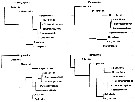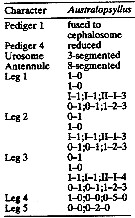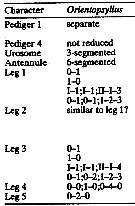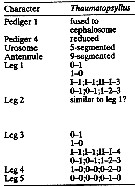|
|
 |
| Thaumatopsyllidae Sars, 1913 ( Cyclopoida ) | | Syn.: | Thespesiopsyllidae Wilson, 1924 (p.16); Wilson, 1932 a (p.393, 604); Sewell, 1949 (p.127); Fosshagen, 1970 a (p.38, Rem.); Isaac, 1975 (n°144/145, p.2, 7, clé spp.); Razouls, 1982 (p.753); Huys & Boxshall, 1991 (Rem., p.154, 193, 420, 467); Razouls, 1993 (p.311) | | Ref.: | Sars, 1913 a (p.4); 1921 a (p.4); Bowman & Abele,1982 (p.13: rétablissent ce nom de famille changé par Wilson (1924); McKinnon, 1994 (p.27, Rem.); J-s. Ho, 1994 (p.1295, Rem.); Ho, Dojiri, Hendler & Deets, 2003 (p.592, Rem.: creation of the new order: Thaumatopsylloida); Boxshall & Halsey, 2004 (p.16; 689: Def., p.691: Genera Key. These authors do not admit the new order Cf. p.41: Rem); Ferrari & von Vaupel Klein, 2019 (p.179: the family belongs to Ordre Thaumatopsylloida and the new Superorder; Rhabdomoplea. Rhabdomoplea appears to be the earliest branch of copepods because only rthoracic somites 1-4 are broad thoughout copepodid developement and thoracic somite 5 and 6 remain narrow, diggerent from Podoplea and Gymnoplea with thoracic somite 5 transformed from the anterior narrow somite to the posterior broad somite during the moult to copepodid II. Rhadomoplea differs from podoplea in their body architecture. | | Rem.: | 4 G: Australopsyllus, Caribeopsyllus, Orientopsyllus, Thaumatopsyllus |  issued from : J.-s. Ho, M. Dojiri, G. Hendler & G.B. Deets in J. Crustacean Biol., 2003, 23 (3). [p.591, Fig.5]. The four, very similar, equally parsimonius phylograms, all showing the Thaumatopsyllidae as sister taxon to the Siphonostomatoida and Monstrilloida. Nota: The phylograms supports Sars' original hypothesis that Thaumatopsyllidae is allied with the Monstrilloida, and also indicate that Sewell (1949) and Fosshagen (1970) were correct to suggest its affinity to the Siphonostomatoida. The trees, however, refute Huys's and Boxshall's (1991) and Boxshall & Halsey (2004) transfer of the family to the Order Cyclopoida. An examination of the 54 characters reveals that thaumatopsyllids differ from Cyclopoida, and justifie the creation of a new order: Thaumatopsylloida. | | | | | (1) Australopsyllus McKinnon, 1994 | |
| | Ref.: | McKinnon, 1994 (p.27); Suarez-Morales & Castellanos, 1998 (p.203, Rem.) | | Rem.: | 1 sp. |  issued from : E. Suarez-Morales & I.A. Castellanos in J. Crustacean Biol., 1998, 18 (1). [p.203, Table 1]. Characteristics female of Australopsyllus. Les Proportions du corps et des appendices sont représentées en valeur relative (%) et en rapport; mesures basées sur les illustrations et les descriptions d'après Sars (1913), Sewell (1949), Fosshagen (1970), Huys & Boxshall (1991) et McKinnon (1994). |
 issued from : McKinnon in Sarsia, 1994, 79. [p.32, Table.1]. Characters of the females. Armature formulae for legs presented as outer margin first. Roman numerals indicate spines, Arabic numerals setae. For legs 1-3, the first line re^resents that of the coxa, the second the basis, the third the exopod, and the fourth the endopod. | | | | | (2) Caribeopsyllus Suarez-Morales, 1998 | |
| | Ref.: | in Suarez-Morales & Castellanos, 1998 (p.199); Boxshall & Halsey, 2004 (p.691) | | Rem.: | 2 spp. |  issued from : E. Suarez-Morales & I.A. Castellanos in J. Crustacean Biol., 1998, 18 (1). [p.203, Table 1]. Characteristics female of Caribeopsyllus. Les Proportions du corps et des appendices sont représentées en valeur relative (%) et en rapport; mesures basées sur les illustrations et les descriptions d'après Sars (1913), Sewell (1949), Fosshagen (1970), Huys & Boxshall (1991) et McKinnon (1994). | | | | | (3) Orientopsyllus Sewell, 1949 | |
| | Ref.: | Sewell, 1949 (p.128); Razouls, 1982 (p.771); Huys & Boxshall, 1991 (p.193); McKinnon, 1994 (p.31, 32, Rem.); Suarez-Morales & Castellanos, 1998 (p.203, Rem.); Boxshall & Halsey, 2004 (p.691) | | Rem.: | type: Orientopsyllus investigatoris. Total: 1 sp. |  issued from : E. Suarez-Morales & I.A. Castellanos in J. Crustacean Biol., 1998, 18 (1). [p.203, Table 1]. Characteristics female of Orientopsyllus. Les Proportions du corps et des appendices sont représentées en valeur relative (%) et en rapport; mesures basées sur les illustrations et les descriptions d'après Sars (1913), Sewell (1949), Fosshagen (1970), Huys & Boxshall (1991) et McKinnon (1994). |
 issued from : McKinnon in Sarsia, 1994, 79. [p.32, Table.1]. Characters of the females. Armature formulae for legs presented as outer margin first. Roman numerals indicate spines, Arabic numerals setae. For legs 1-3, the first line re^resents that of the coxa, the second the basis, the third the exopod, and the fourth the endopod. | | | | | (4) Thaumatopsyllus Sars, 1913 | |
| | Syn.: | Thespesiopsyllus Wilson, 1924 (p.16, Rem.); 1932 a (p.604); Sewell, 1949 (p.128); Fosshagen, 1970 a (p.33); Razouls,1982 (p.753); Huys & Boxshall, 1991(p.193, 467); Razouls, 1993 (p.312) | | Ref.: | Sars, 1913 a (p.4); 1921 a (p.4); Rose, 1933 a (p.338); McKinnon, 1994 (p.27, 32, Rem.); Suarez-Morales & Castellanos, 1998 (p.203, Rem.); Boxshall & Halsey, 2004 (p.691) | | Rem.: | type: Thaumatopsyllus paradoxus. Total: 1 sp. |  issued from : E. Suarez-Morales & I.A. Castellanos in J. Crustacean Biol., 1998, 18 (1). [p.203, Table 1]. Characteristics female of Thaumatopsyllus. Les Proportions du corps et des appendices sont représentées en valeur relative (%) et en rapport; mesures basées sur les illustrations et les descriptions d'après Sars (1913), Sewell (1949), Fosshagen (1970), Huys & Boxshall (1991) et McKinnon (1994). |
 issued from : McKinnon in Sarsia, 1994, 79. [p.32, Table.1]. Characters of the females. Armature formulae for legs presented as outer margin first. Roman numerals indicate spines, Arabic numerals setae. For legs 1-3, the first line re^resents that of the coxa, the second the basis, the third the exopod, and the fourth the endopod. For Thaumatopsyllus, some specimens may have a 1-segmented endopod, with 1 terminal seta, on leg P4. | | | | | | | | |
|
|
 Toute utilisation de ce site pour une publication sera mentionnée avec la référence suivante : Toute utilisation de ce site pour une publication sera mentionnée avec la référence suivante :
Razouls C., Desreumaux N., Kouwenberg J. et de Bovée F., 2005-2025. - Biodiversité des Copépodes planctoniques marins (morphologie, répartition géographique et données biologiques). Sorbonne Université, CNRS. Disponible sur http://copepodes.obs-banyuls.fr [Accédé le 18 septembre 2025] © copyright 2005-2025 Sorbonne Université, CNRS
|
|
 |
 |











